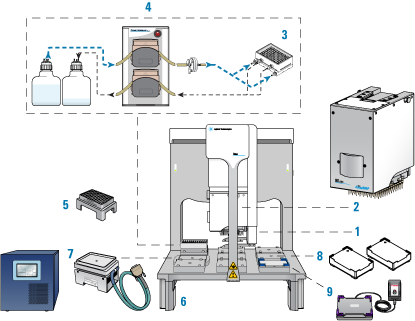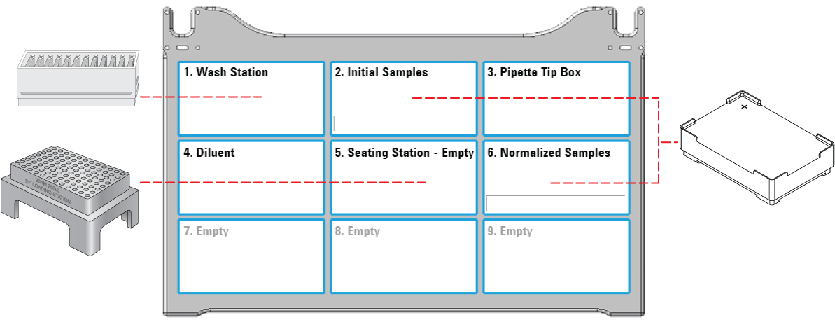Before you start

This topic lists the required hardware, software, labware, and solutions for running the Normalization protocol. If you have questions about these items, contact Agilent Customer Service.
Hardware
The AssayMAP Bravo Platform is required for running the AssayMAP protocols. The following figure and table describe the platform components.
Figure AssayMAP Bravo Platform components
 |
Item | Required hardware |
|---|---|
1 | Gripper upgrade |
2 | Bravo 96AM Head |
3 | 96AM Wash Station |
4 | Pump Module 2.0 and two carboys |
5 | 96AM Cartridge & Tip Seating Station |
6 | Bravo Risers, 14.6 cm |
7 | Peltier Thermal Station with STC controller |
8 | Plate Risers, 2.84 cm (two) |
9 | Orbital Shaking Station with Control Unit |
Optional equipment. The following equipment is recommended when preparing the samples and reagents:
• Microplate centrifuge, such as the Agilent VSpin Microplate Centrifuge or equivalent
• Microplate sealer, such as the Agilent PlateLoc Thermal Microplate Sealer or equivalent
Software
The following table lists the minimum software requirements.
Software | Version |
|---|---|
Agilent VWorks Plus (compliance-enabled edition) or VWorks Standard | 14.4 |
Agilent Protein Sample Prep Workbench | 4.0.2 |
Microsoft Excel Required for the reagent volume calculators and method setup tools. | Microsoft Office 365 32-bit edition |
For an overview of the software components, see Overview of software architecture.
Labware
The Normalization protocol requires the following labware:
• Full tip box of 96 250-µL pipette tips, Agilent 19477-002
• Labware for the diluent reservoir, initial samples plate, and normalized samples plate
The following table provides a complete list of labware options and the corresponding deck locations.
The following figure shows the nine Bravo deck locations for labware.
Figure Accessory and labware locations on the Bravo deck (top view)
 |
Labware | Manufacturer part number* | Deck location options |
|---|---|---|
96 ABgene 1127, 1mL Deep Well, Square Well, Round Bottom | ABgene AB-1127 | 2, 6 |
96 Eppendorf 30129300, PCR, Full Skirt, PolyPro | Eppendorf 30129300 | 2, 6 |
96 Greiner 652270, PCR, Full Skirt, PolyPro | Greiner 652270 | 2, 6 |
96 Greiner 650201_U-Bottom, Clear PolyPro | Greiner 650201 | 2, 6 |
96 Greiner 650207_U-Bottom, White PolyPro | Greiner 650207 | 2, 6 |
96 Greiner 651201_V-Bottom, Clear PolyPro | Greiner 651201 | 2, 6 |
96 Costar 3363, PP Conical Bottom | Corning Costar 3363 | 2, 6 |
96 Greiner 675801, Half Area, Flat-Bottom, UV Star | Greiner 675801 | 2, 6 |
12 Column, Low Profile Reservoir, Natural PP | Agilent 201280-100 | 4 |
8 Row, Low Profile Reservoir, Natural PP | Agilent 201282-100 | 4 |
96 V11 Manual Fill Reservoir | Agilent G5498B#049 | 4 |
Reservoir, Axygen Scientific RES‑SW96-LP, 86mL pyramid bottom | Axygen Scientific RES‑SW96-LP | 4 |
*For dimensionally equivalent alternatives and other details about the labware, see the Labware Reference Guide in the Literature Library page of the Protein Sample Prep Workbench. | ||
The unusable volume (also known as dead volume) is the volume that cannot be reliably aspirated from the microplate well due to pipetting limitations that arise from differences in well-bottom geometry. The following table provides some general guidelines on how different microplate geometries can affect this value.
Table Guidelines on how microplate geometry can affect volume requirements
Well-bottom geometry | Examples | Unusable volume expectations |
|---|---|---|
Flat bottom | Greiner 675801 | Generally, the worst plates for minimizing dead volume. Liquids are attracted to the intersection of the plate bottom and side walls. |
Round (U) bottom | Greiner 650201, Greiner 650207 | Generally, good options for minimizing dead volume. A round bottom forces liquid to collect in the center of the well at a medium rate. |
V-bottom and PCR | • V-Bottom: Greiner 651201, Corning Costar 3363 • PCR Plate: Eppendorf 30129300, Greiner 652270 | Generally, the best plates for minimizing dead volume. Steep side walls force liquid to collect in the center of the well, making it easy to access. |
For volume overage recommendations by labware type, see the Labware Reference Guide in the Literature Library page of the Protein Sample Prep Workbench.
Solutions
The Normalization utility requires the following solutions:
• Diluent to adjust the sample concentration
• Purified water for the wash station reservoir (carboy)